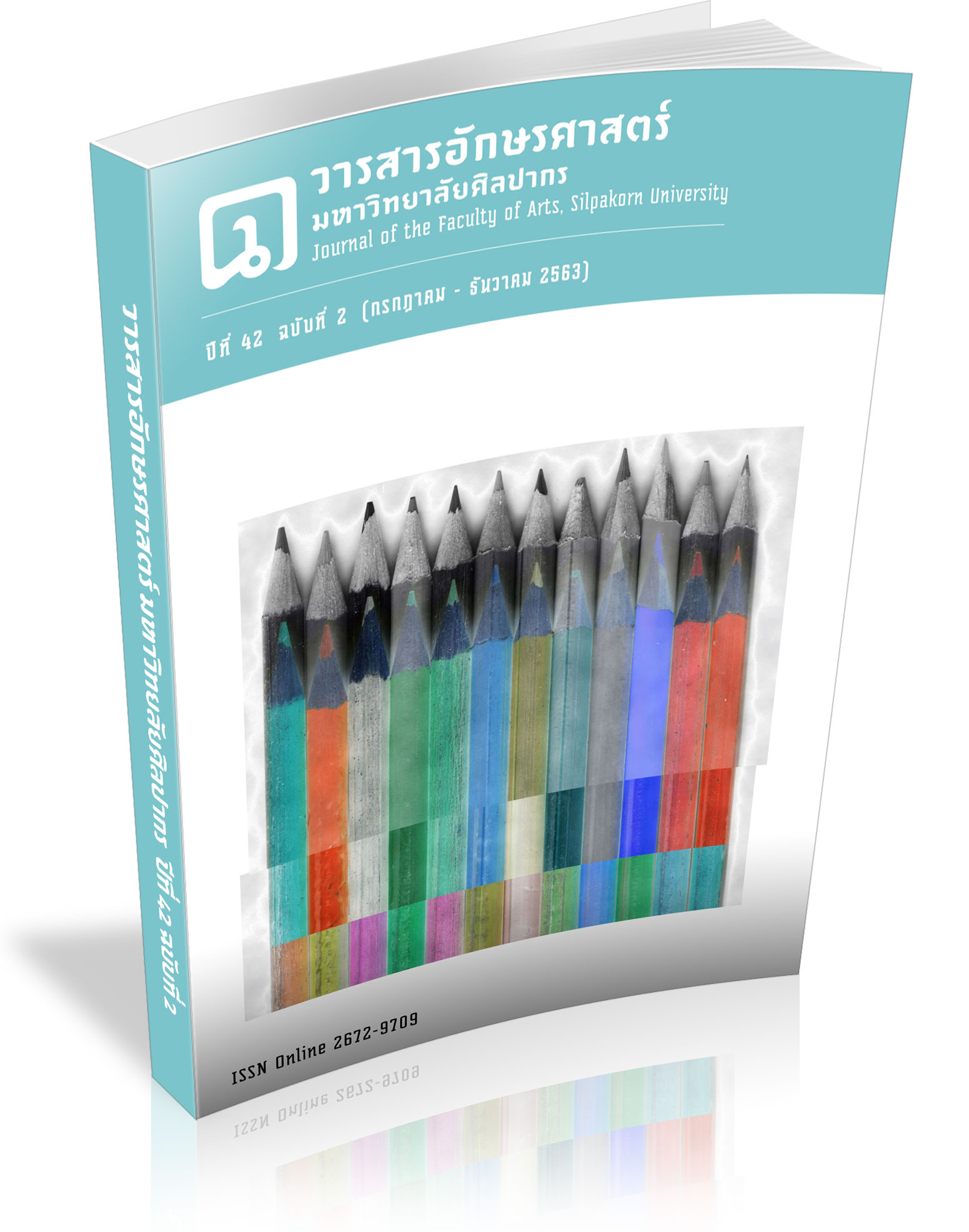Semantic Changes at the Construction Level of the GOAL Schematic Structure in Thai
Keywords:
semantic change, GOAL schematic structure, construction, cognitive semanticsAbstract
This article aims to analyze the contextual meanings of the GOAL schematic structure ‘be Y to X’ in Thai, the semantic relation of the GOAL schematic structure ‘be Y to X’ from the cognitive semantic perspective and the semantic changes of the GOAL schematic structure ‘be Y to X’ from the cognitive semantics and historical linguistic perspectives. Data investigated in this research derived from prose dated from 1357 to 2017, totaling 418 occurrences. The results show that there are three contextual meanings of the GOAL schematic structure: ‘GOAL’, ‘RECIPIENT’ and ‘POSSESSION’. All three meanings are metonymically contiguous. Explanation for the semantic extension from the cognitive semantic perspective is that the GOAL schematic structure is the source of the construction, which is semantically extended to ‘RECIPIENT’ and ‘POSSESSION’. When the semantic changes were examined using the historical data, it was found that ‘POSSESSION’ was the first meaning appearing in 1357, while ‘GOAL’ and ‘RECIPIENT’ were later found. However, ‘POSSESSION’ does not exist in the present day. Only ‘GOAL’ and ‘RECIPIENT’ still remain. This research confirms the validity of the concept that the semantic changes are not only limited at the lexical level but can also be considered at the construction level.
Downloads
References
Bandhumedha, N. (2016). Thai Grammar. 8th ed. Bangkok: Chulalongkorn University. (In Thai)
Croft, W. and Cruse, D. A. (2004). Cognitive Linguistics. New York: Cambridge University Press.
Dixon, R. M. (2010). Basic Linguistic Theory Volume 2: Grammatical Topics. Oxford: Oxford University Press.
Evans, V. and Green, M. (2006). Cognitive Linguistics: An Introduction. Edinburgh: Edinburgh University Press.
Heine, B. (1994). Areal Influence on Grammaticalization. In: Piitz, Language Contact, pp. 55-68.
Heine, B. (1997). Cognitive Foundations of Grammar. Oxford: Oxford University Press.
Heine, B. (1999). Possession: Cognitive Sources, Forces and Grammaticalization. Cambridge: Cambridge University Press.
Hespelmath, M. (1999). External Possession in a European Areal Perspective. In Payne, D. L. and Barshi, I. (Eds). External Possession (Typological Studies in language 39). Amsterdam: John Benjamins.
Hiranras, J. (2007). A Semantics Study ‘TAKE’ in Thai. Masters Dissertation, M.A. in Linguistics, Chulalongkorn University, Thailand. (In Thai)
Jaratjarungkiat, S. (2012). The Development of the word /pen/ in Thai. Dissertation, Ph.D. in Thai, Chulalongkorn University, Thailand. (In Thai)
Kövecses, Z. (2006). Language, Mind, and Culture: A Practical Introduction. Oxford and New York: Oxford University Press.
Langacker, R. W. (1987). Foundations of Cognitive Grammar, vol. 1, Theoretical Prerequisites. Stanford: University Press.
Langacker, R. W. (1991a). Foundations of Cognitive Grammar, vol. 2, Descriptive Application. Stanford: University Press.
Langacker, R. W. (1991b). Concept, Image, and Symbol: The Cognitive Basic of Grammar. Berlin: De Gruyter Mouton.
Langacker, R. W. (2000). Why a Mind is Necessary: Conceptualization, Grammar and Linguistic Semantic. In Liliana Albertazzi. (Ed.) Meaning and Cognition: A Multidisciplinary Approach. Amsterdam: John Benjamins.
Langacker, R. W. (2016). Linguistic Construal and Conceptual Analysis. Retrieved July 1, 2019, from Web site: https://workshoplinc2016.files.wordpress.com/2016/08/construal- handout.pdf
Langacker, R. W. (2017). Lecture 1-Ten Lectures on the Elaboration of Cognitive Grammar. https://doi.org/10.1163/9789004347465
Mueanjai, S. (2011). Construction Expressing Three-Participant Events in Thai. Doctoral Dissertation, Ph.D. in Linguistics, Chulalongkorn University, Thailand. (In Thai)
Payne, D. L. and Barshi, I. (1999). External Possession (Typological Studies in language 39). Amsterdam: John Benjamins.
Pongsripian, W. (2020). The Study of Sukhothai Period: History, Inscription and Etymology. Nakhon Pathom: Silpakorn University Press. (In Thai)
Pothipath, V. (1999). Analytic Causative Constructions in Thai. Masters Dissertation, M.A. in Linguistics, Chulalongkorn University, Thailand. (In Thai)
Pothipath, V. (2001). Construction Grammar. Journal of Thai Language and Literature. 18: 114 - 131. (In Thai)
Pothipath, V. (2019). Typological Perspectives on Thai. Bangkok: Chulalongkorn University, Thailand. (In Thai)
Radden, G. (2003) How Metonymic Are Metaphors? In A. Barcelona (ed.) Metaphor and Metonymy at the Crossroad: A Cognitive Perspective, pp. 93-108. Berlin; New York: Mouton de Gruyter.
Rice, S. (1999). “Patterns of Acquisition in the Emerging Mental Lexicon: The Case of to and for in English.” Brain and language 68: 268-276.
Rice, S. and Kabata K. (2007). Crosslinguistic Grammaticalization Patterns of the ALLATIVE. Linguistic Typology. 11: 451-514.
Saralamba, C. (1995). A Conceptual Study of /khăw/. Doctoral Dissertation, Ph.D. in Linguistics, Chulalongkorn University, Thailand. (In Thai)
Thepkanjana, K. (2016). Grammaticalization. Bangkok: Faculty of Arts, Chulalongkorn University. (In Thai)
Thepkanjana, K., and Uehara, S. (2007). A Typological Study of Resultative Constructions. Bangkok: Faculty of Arts, Chulalongkorn University.
Traugott, E. C. and Dasher, R. B. (2005). Regularity in Semantic Change. Cambridge: Cambridge University Press.
Wongsri, K. (2004). A Semantics Network of /ʔook/ in Thai: A Cognitive Semantic Study. Masters Dissertation, M.A. in Linguistics, Chulalongkorn University, Thailand. (In Thai)
Downloads
Published
How to Cite
Issue
Section
License
ผู้เขียนบทความต้องยินยอมในข้อกำหนดต่าง ๆ ของวารสารก่อนส่งบทความตีพิมพ์




